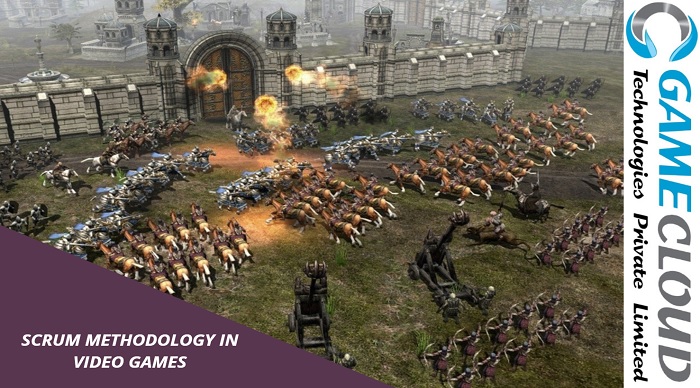
Is your game development team searching for the best possible practices in video game development? If yes, adopting scrum methodology will surely increase your chance of building a better game with great results.
In this blog, we will walk you through the basics of scrum methodology, scrum testing, features of scrum methodology.
WHAT IS SCRUM?
Scrum is a process or methodology for building complex software applications. For instance, video games. It focuses on teamwork and accountability. It helps the game development team to focus on different aspects like performance, usability, quality, etc.
KEY ASPECT OF SCRUM METHODOLOGY:
- The scrum team may consist of 3-5 expert members who work on the project.
- It has a short game build release cycle that is adjustable and lasts from two to four weeks known as sprints.
- After each sprint, there is a process of testing and applying new changes to the game development known as stories.
- The three basic pillars are as follows-

ROLES:
Under this, there are three main roles- Product Owner, Scrum Master, & Development Team.
ARTIFACTS:
- User Stories: a brief explanation of the system functionalities.
- Product Backlog: A collection of user stories owned by the product owner for scrum products.
- Release Backlog: A particular time in which multiple iterations are completed. It is coordinated between the product owner and scrum master to check which stories must be taken for the release.
- Sprints: A time frame to complete the user stories.
- Sprint Backlog: A set of user stories to be completed in a sprint.
- Block List: List of unplanned and canceled events updated daily by the scrum master.
- Burndown Chart: A graphical representation of the completed and in progress tasks.
SCRUM CEREMONIES:
- Sprint Planning: In Sprint planning, teams take user stories from the release backlog and navigate them into the sprint backlog for further processing.
- Daily Scrum: Owned by the scrum master, there is a 5-minute daily status meeting to discuss the work done, the upcoming work of every team member.
- Sprint Review: It is hosted by scrum master to determine the work that has been completed in the last sprint and things that need to be improved.
WHAT IS SCRUM TESTING?
In Scrum methodology, testing is done in to check for non-functional parameters like security, reliability, usability, performance, etc.
IS THERE ANY TESTER IN SCRUM?
In general, there is no active tester in the scrum however unit tests are carried out by the development team itself. Also, some scrum methodologies have a team of dedicated testers depending upon the complexity of the project.
WHAT ARE THE TESTING ACTIVITIES IN SCRUM?
Let us now see the activities carried out by the testers in scrum methodology
1. Sprint Planning:
- The tester should pick a story that needs to be tested from the product backlog.
- Need to provide estimation for testing the stories.
- Must be aware of sprint goals.
- Must prioritize the testing work.
2. Sprint:
- Help in unit testing.
- User story testing once completed.
- Must attend all the meetings, daily scrum.
- Need to keep a track of any item that might not have been completed in the previous sprint.
- Execute nonfunctional testing for approved user stories.
- Testers should check for UAT acceptance testing in some cases and confirm the same for the current sprint.
3. Sprint Review:
- Track things that were successfully implemented and things that were not.
- Need to identify best practices for future reference.
GROWING USE OF SCRUM FOR VIDEO GAME INDUSTRY
Being an agile project management framework, Scrum helps to define a set of meetings, roles and tools that work collaboratively to help team management process. In this case, you get the below benefits
- Developers who focus on adapting and implementing changes as per the standard of the industry.
- A good working environment with daily meetings to know the progress.
With regular changes in the video game industry relying on an agile scrum in game development can help to add up the changes without disturbing the actual element.
SOME OF THE MAJOR SNAGS IN SCRUM-
- Task prioritizing and time estimation calculated even before the GDD.
- GDD (Game Design Document) is sometimes replaced by a backlog sheet.
- Unnecessary and time-consuming routine meetings in many cases.
- Waiting for task assignments for Project managers.
- Completing scrum stories and splints way before QA admission.
- Unnecessary implementations of Scrum creating delays in game development.
- Pushing for bottom-up code design approach based on limited game design.
CONCLUSION:
Scrum Methodology in video games allows us to work parallelly with the industry changes happening. With a detailed process definition, it becomes easy to maintain transparency amongst each team member and ensure evident results at the end of each cycle. Still, as a game development studio, if you already have an established and comfortable methodology for your game development process, there is really no need to experiment with Scrum!
